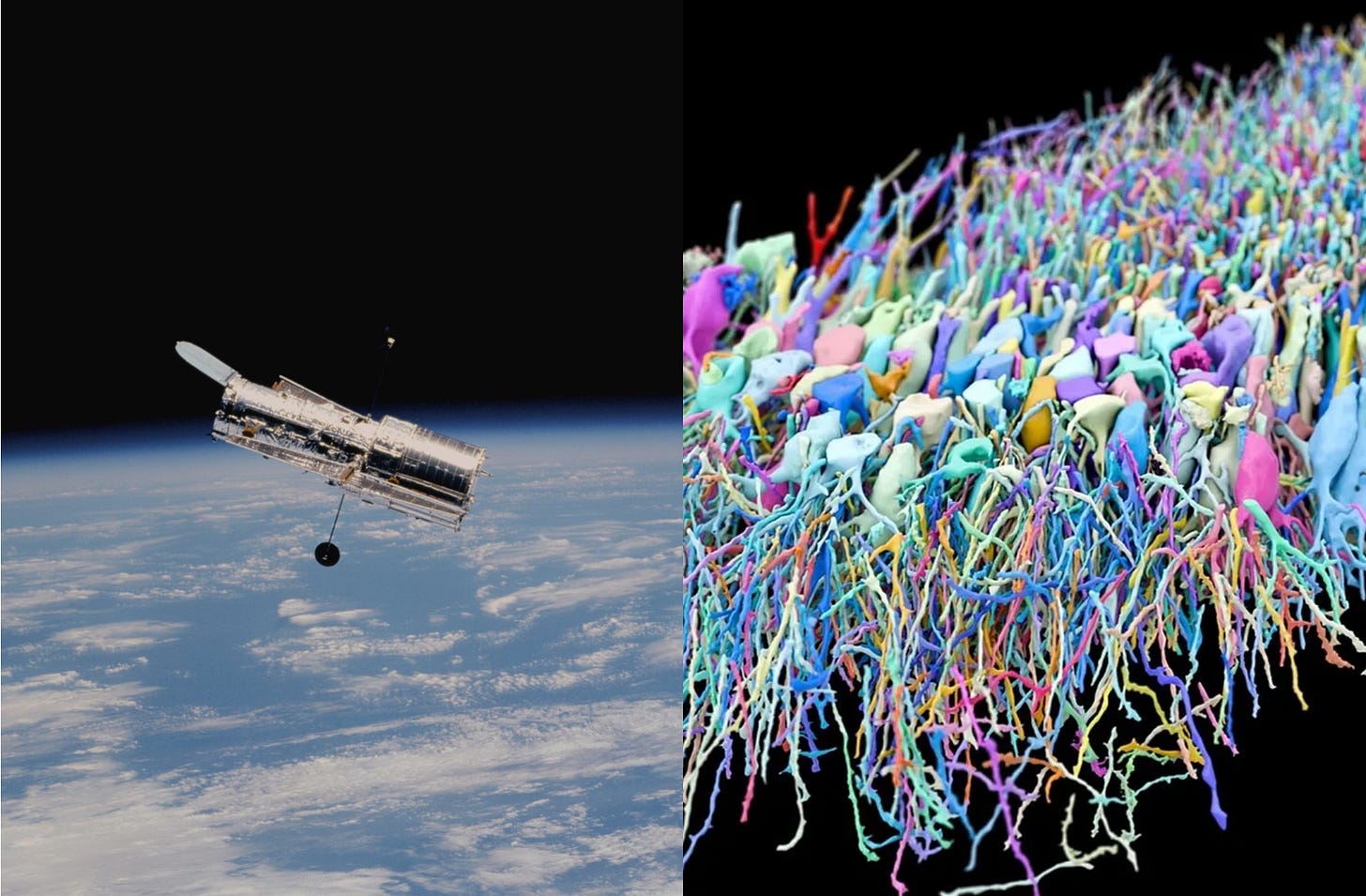Scientific research has been held back by the very systems driving it.
There’s no shortage of intelligence among our scientists, nor creativity and hard work. But there are essential technologies missing across many of the most important scientific disciplines that would unlock significant breakthroughs—tools, datasets, and platforms that empower new discovery.
These are solvable bottlenecks. Consider how space telescopes, particle accelerators, and genome sequencers reveal a deeper world to us and open new domains of exploration and discovery. What has enabled these leaps? New ways of organizing science.
The teams that can build the tools we need to overcome today’s bottlenecks don’t have a natural home. Academic labs and startup companies will play an indispensable role in the future of technology, but university astronomy labs couldn’t have launched the Hubble Space Telescope on their own, nor would a venture-backed startup have built the Large Hadron Collider at CERN. Hubble and CERN illustrate a common pattern in science: a need for projects that are bigger than an academic lab can undertake, more coordinated than a loose consortium, and not directly profitable enough to be a venture-backed or industry R&D.
Focused Research Organizations (FROs) fit in this complementary role. Our non-profit has launched 10 FROs over the last three years to address the bottlenecks in areas essential to humanity, from neuroscience to synthetic biology to climate tech. All have a focused, five year mission to create new enabling infrastructures to break through scientific bottlenecks.
University astronomy labs couldn’t have launched the Hubble Space Telescope on their own, nor would a venture-backed startup have built the Large Hadron Collider at CERN.
Breaking bottlenecks to build essential scientific infrastructure can have unexpected results. AI experienced transformational change when pivotal advances in infrastructure (cheap computing, software, abundant internet data, etc) unlocked its potential. We believe it is possible to transform many fields in the same way. Mountains of what Michael Nielsen calls “intellectual dark matter” are rumbling on the verge of some unknown technological eruption that will forever release their impact.
This is our vision for building essential technology.
Building “bridge-scale” science
Essential technology doesn’t have to be “big” science on the order of the Large Hadron Collider and the Human Genome Project. It can instead be a bridge between those once-in-a-generation megaprojects and the work from individual researchers in small labs.
Bridge scale teams operate more like startups, with nimble yet tightly coordinated teams of 20-30 people converging on a specific scientific bottleneck, with skills focused on building a particular technology that advances whole fields of science. These projects are outside of the scope of a PhD thesis or loose collaboration and they are also not VC-fundable commercial projects; rather than expecting a single novel result or an outsized financial return, these efforts generate an outsized scientific return on investment, unlocking productivity for an entire field.
Our research ecosystems are great at developing brilliant academics and commercial products, but are stymied by bottlenecks that need such a bridge. For example, theoretical neuroscientists can’t actually see the detailed structure of the brain, and have instead been forced to model it as a random network or make other oversimplified assumptions. But what if instead of having to speculate, we had tools that make brain mapping 100x cheaper and could get the actual circuit maps of the real brain? Theoretical neuroscience would see a renaissance, as would the study of intractable brain diseases.
These are essential technologies achievable by focused startup-sized teams. They are bridges that blur the boundaries between basic and applied science. To illustrate, is a tool as fundamental as CRISPR basic or applied science? The reality for this particular essential technology and many others is that it’s both at once. Applied work can speed up basic research and vice versa. Fundamental tools that give scientists more access to the brain, decode the language of the human immune system, create tools that advance mathematics with AI, or 100X our ability to map protein interactions in health and disease would all be catalytic for both fundamental advancement and applications.
Rather than expecting a single novel result or an outsized financial return, FROs generate an outsized scientific return on investment, unlocking productivity for an entire field.
Building up problem-solvers
In the middle of the 20th century, Vannevar Bush noticed a gap in the research ecosystem. Centralized wartime science was thriving, including the Manhattan Project, the Rad Lab, and breaking the Enigma code. But there wasn’t a large-scale decentralized ecosystem for training and curiosity. Bush responded by helping establish the National Science Foundation.
The scientific ecosystem that emerged has since become excellent at “planting seeds” by training scientists and funding curiosity in our academic institutions. And we still deeply need that part of the ecosystem. But now we also need better approaches for realizing the bridging advances that converge resources into the most fertile plots, and the people who can make that possible. For example, neuroscientists have uncovered many promising options for integrating brain-computer interfaces; Forest Neurotech focused resources on chip design for brain ultrasound devices, and quickly made large strides toward interfacing with human brain activity.
We aim to solve the three-way optimization problem of connecting talent and funding to the technology roadmaps that can break through scientific bottlenecks.
Humanity could increase its rate of scientific and technological advancement by driving free energy into about 100 especially catalytic projects within reach. If there are ~20 fundamental fields of science, and within each there are ~3-5 pivotal elements of scientific infrastructure that the existing science establishment can’t build, that's an unmet need on the order of ~100 bridge-scale projects. If each costs $20-50M for a massively enabling sprint, that’s a few $B in input that could unlock trillions in societal value as outputs via accelerated R&D progress.
As we create the organizational and financial means to build these solutions, scientists will gain a broader palette of career options. Many scientists want to combine the well-resourced, team-focused, and impact-targeted working environment of a deep-tech startup with the ability to create foundational public goods that “lift all boats” for scientists, regardless of potential returns to venture capitalists. Working in a FRO is a unique opportunity to use non-dilutive funding to build a transformative technology platform and become science entrepreneurs. An impactful platform should lead to post-FRO business and career opportunities as well. While we build tools to enable the science we need, bridge-scale projects attract and nurture a special breed of people who we expect to continue to impact science and society.
A call to action: Are you a scientist who wants to lead or join a different type of team? Are you a funder looking to accelerate science? Do you see a bottleneck in science that new bridge-scale tools, systems or datasets could transform?
At Convergent, we want to steer the engine of non-profit deep tech that we are building towards the most positively impactful problems for humanity now and in the long term.
We won’t choose randomly among these 100 or so essential technologies. We are motivated by society’s pressing challenges. For example, as biology and AI both accelerate at an unprecedented pace, we aim to drive differential progress in security and safety so that we can accelerate to the benefits without falling victim to unacceptable risks – leading to a focus on biosecurity and on fundamental methods supporting safe by design AI, like formal mathematical theorem proving.
Our current open call is a request for FROs in the UK. The deadline for submitting a concept paper has been extended to February 16. Check out the call and submit your ideas for critical bottlenecks and how to bridge them with essential technologies.








The problem with the NSF, is that its long term effect was to bureaucratize science.